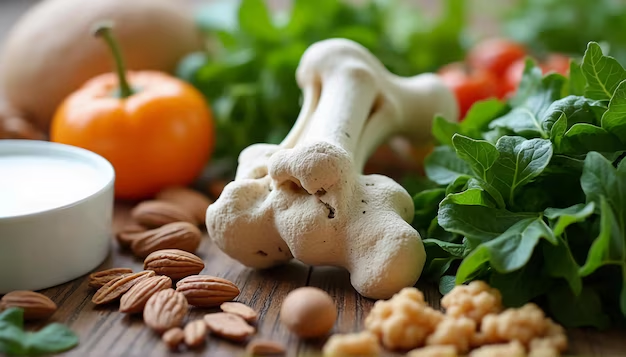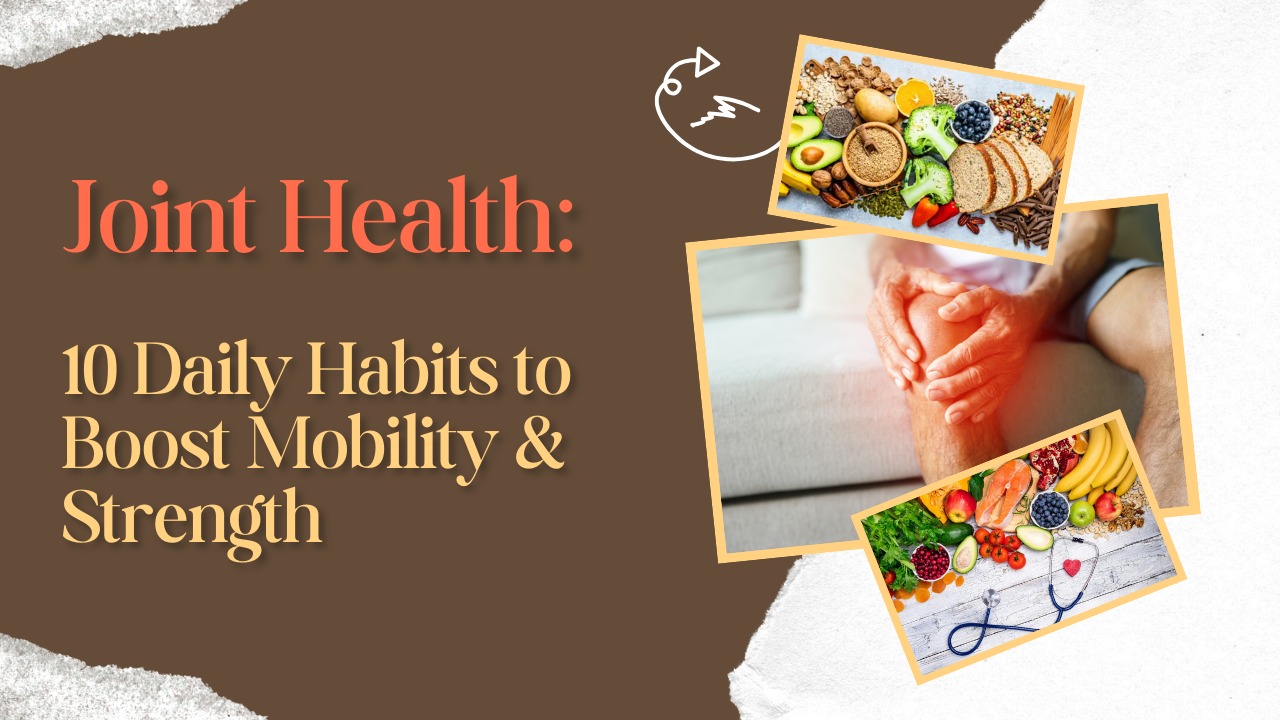Maintaining joint health is key to staying active and pain-free throughout life. As we age or perform repetitive tasks, joints can become stiff, inflamed, or more susceptible to injury. It’s important to address these changes early to prevent long-term discomfort and mobility issues.
There are several habits you can adopt to improve joint health. Regular exercise, particularly low-impact activities like swimming or cycling, helps keep joints flexible and strong. Incorporating stretches and mobility exercises can also promote flexibility and reduce stiffness.
In addition to exercise, maintaining a balanced diet rich in anti-inflammatory foods, vitamins, and minerals supports joint health. Proper hydration, weight management, and avoiding overuse of joints also contribute to long-term well-being. By following these habits, you can strengthen your joints, reduce pain, and ensure they remain functional for years to come.
Engage in Regular Mobility Exercises
Regular mobility exercises are essential for promoting joint health by maintaining flexibility and strength. These exercises help increase the range of motion in your joints, reduce stiffness, and improve overall mobility. They also support circulation, which aids in reducing inflammation and promoting healing in the joints. By consistently incorporating mobility exercises into your routine, you can prevent injuries, enhance joint function, and minimize discomfort. Prioritizing joint health through mobility exercises ensures long-term well-being and keeps your joints strong and flexible as you age. These exercises help in:

Increasing Range of Motion: Regular movement prevents joints from becoming stiff and maintains their full range of motion.
Enhancing Synovial Fluid Production: Movement stimulates the production of synovial fluid, which lubricates joints and reduces friction.
Strengthening Supporting Muscles: Exercises like yoga, Pilates, and tai chi not only improve flexibility but also strengthen the muscles surrounding the joints, providing better support.
Including dynamic stretches and low-impact exercises into your daily routine to keep your joints healthy and mobile.
Maintain a Healthy Weight
Excess weight puts extra strain on weight-bearing joints, including the knees, hips, and spine. This added pressure can lead to joint pain and significantly increase the risk of developing conditions like osteoarthritis. Maintaining a healthy weight helps reduce this strain, lowering the risk of joint discomfort and long-term damage. By managing weight effectively, you can protect your joints and improve overall mobility, promoting long-term joint health and reducing the likelihood of painful conditions.
To protect your joints:
Follow a Nutritious Diet: Focus on eating a variety of fruits, vegetables, lean proteins, and whole grains.
Stay Active: Include both cardio and strength-training exercises to help maintain a healthy weight.
Control Portions: Pay attention to portion sizes to prevent overeating and avoid excess weight gain.
By maintaining a healthy weight, you reduce the strain on your joints and lower the risk of joint-related issues.

Stay Hydrated
Staying properly hydrated is crucial for maintaining joint health. Water helps lubricate the joints, reducing friction and preventing stiffness. It also supports the transport of essential nutrients to the cartilage, promoting healing and reducing inflammation. Dehydration can lead to joint discomfort and decreased mobility, making it important to drink enough water throughout the day. Ensuring proper hydration contributes to better joint function, alleviates pain, and supports overall long-term joint health.
Maintaining Joint Lubrication: Proper hydration is essential for keeping your joints well-lubricated, which helps reduce friction and wear. When joints are adequately hydrated, they move more smoothly, minimizing the risk of discomfort and injury.
Supporting Cartilage Function: Cartilage serves as a cushion between bones, and it depends on water to maintain its structure and function. Staying hydrated ensures that cartilage remains healthy, absorbing nutrients and providing effective shock absorption for your joints.
Reducing Inflammation: Drinking enough water helps flush toxins from the body and can significantly reduce inflammation. Hydration supports the body’s natural detoxification processes, which helps alleviate joint swelling and pain, promoting better overall joint health.
Aim to drink at least 8 glasses (about 2 liters) of water daily, more if you’re physically active or in a hot climate.
Adopt Proper Posture
Maintaining proper posture is crucial for joint health, as it helps distribute body weight evenly across the joints. Poor posture can lead to increased stress on specific joints, causing strain, pain, and potential long-term damage. By standing and sitting with proper alignment, you reduce the risk of joint discomfort and improve overall body mechanics. Correct posture also supports muscle function and spinal health, ensuring that your joints are better supported and less prone to injury or degeneration over time.
Poor posture can lead to:
Uneven Weight Distribution: This causes certain joints to bear more weight than others, leading to excess strain.
Increased Joint Stress: Especially in areas like the spine, hips, and knees, improper posture can put extra pressure on these joints.
Muscle Imbalances: Poor posture can lead to imbalances in muscle strength, resulting in discomfort and a higher risk of injury.
To improve posture:
Be Mindful of Alignment: Ensure that your ears, shoulders, and hips are aligned when standing.
Adjust Workstations: Set up your desk and chair to promote a neutral spine position.
Take Regular Breaks: Stand, stretch, and move around every 30 minutes to prevent stiffness.
Good posture reduces unnecessary strain on your joints, particularly in the back and hips.
Include Joint-Friendly Foods
Nutrition is crucial for maintaining joint health, as the right nutrients support cartilage, reduce inflammation, and promote overall joint function. A diet rich in vitamins, minerals, and healthy fats can help protect joints from wear and tear. Omega-3 fatty acids, found in foods like fish and flaxseeds, can reduce joint inflammation, while vitamin C and antioxidants help repair cartilage and tissues. Proper nutrition strengthens joints, reduces pain, and supports long-term mobility, ensuring joints remain healthy and functional.

Include the following in your diet:
Omega-3 Fatty Acids: Found in fatty fish such as salmon, as well as walnuts and flaxseeds, omega-3s help reduce inflammation in the joints.
Vitamin D: Crucial for calcium absorption and maintaining bone health, vitamin D can be obtained from fortified dairy products and sunlight exposure.
Antioxidant-Rich Foods: Foods like berries, leafy greens, and nuts help fight oxidative stress, protecting joints from damage.
Collagen-Boosting Foods: Bone broth, citrus fruits, and leafy greens support collagen production, which is essential for maintaining healthy cartilage.
A balanced diet rich in anti-inflammatory foods can help keep your joints healthy.
Engage in Strength Training
Building muscle around your joints provides added support and stability. Benefits include:
Improved Joint Protection: Building strong muscles helps absorb shock and reduces the strain placed on your joints. Well-developed muscles act as a cushion, preventing excessive wear and tear on the joints and lowering the risk of injury over time.
Better Balance and Coordination: Strengthening muscles also enhances balance and coordination, which is crucial in reducing the risk of falls and related injuries. Improved stability helps maintain safe movement patterns and prevents accidents, especially as we age.
Boosted Metabolism: Regular physical activity increases muscle mass, which in turn boosts metabolism. This helps with weight management by promoting calorie burning and supporting overall health. A higher metabolism supports fat loss, keeps joints healthy, and contributes to better energy levels.
Including exercises like squats, lunges, and resistance training into your routine at least twice a week.
Take Regular Breaks from Repetitive Tasks
Repetitive movements, such as typing, running, or lifting, can put continuous stress on specific joints, leading to wear and tear over time. This constant strain may result in joint discomfort, inflammation, or even injury if not managed properly. Overuse of particular joints can reduce their flexibility and functionality, increasing the risk of developing conditions like tendinitis or osteoarthritis. It’s important to take regular breaks, maintain proper posture, and incorporate strengthening exercises to prevent joint damage from repetitive activities.

These overuse injuries can cause:
Tendinitis, due to repeated stress on tendons.
Bursitis, from inflamed fluid-filled sacs near joints.
Carpal tunnel syndrome, due to wrist overuse.
To prevent injury:
Take microbreaks every 30–60 minutes.
Change posture and hand positions during activities.
Cross-train if you’re an athlete (e.g., alternate swimming and cycling with running).
Use ergonomic tools that reduce joint strain (keyboards, chairs, lifting aids).
Variety in movement is key to balanced joint use and long-term durability.
Prioritize Sleep and Recovery
Joints repair and regenerate during sleep, as the body works to reduce inflammation and rebuild damaged tissues. Adequate rest is essential for supporting this natural healing process. Without sufficient sleep, the body has a harder time managing inflammation and repairing joint tissues, which can lead to increased pain and discomfort. Prioritizing quality sleep helps maintain joint health, improve recovery, and support overall well-being, ensuring your joints remain strong and functional. Quality sleep helps:
Release growth hormone, essential for tissue repair.
Reduce cortisol levels, preventing joint inflammation.
Improve coordination and motor control, reducing injury risk.
Aim for 7–9 hours of quality sleep. Establish a calming bedtime routine, keep your room cool and dark, and avoid screens before bed.
Don’t overlook active recovery days—walking, stretching, foam rolling, or swimming on rest days can increase circulation and enhance healing.
Use Proper Techniques During Exercise
Improper form is a major contributor to joint injuries. Whether lifting weights, running, or practicing yoga, using incorrect technique can put undue stress on your joints, increasing the risk of strain and damage. Maintaining proper posture and alignment during physical activities is crucial to protect your joints, reduce the chance of injury, and ensure that exercises are effective and safe for your body.
Common mistakes include:
Letting knees cave in during squats (valgus knee collapse).
Hyperextending joints (locking knees or elbows).
Poor core engagement, placing extra strain on the back and hips.
To ensure safety:
Warm up before all workouts with dynamic movements.
Start with bodyweight before adding external resistance.
Use mirrors or trainers to check your form.
Proper mechanics not only protect your joints but also maximize workout efficiency and gains.
Listen to Your Body
Perhaps the most underrated habit: learning to interpret your body’s signals. Pain, swelling, stiffness, or limited range of motion often indicate that your joints need rest or medical attention.

Ignoring early signs can lead to:
Chronic inflammation or arthritis.
Ligament or tendon tears.
Loss of joint mobility over time.
If you notice persistent joint pain:
Reduce activity and apply ice to inflamed areas.
Incorporate gentle movement and rest.
See a healthcare professional if symptoms persist.
Respecting your limits and being proactive with care will ensure long-term joint functionality.
Bonus Tips for Joint Longevity
Foam rolling and self-myofascial release: Helps relieve tight muscles that pull on joints.
Epsom salt baths: Reduce inflammation and soothe joint discomfort.
Massage and physical therapy: Support recovery and flexibility.
Supplements: Glucosamine, chondroitin, turmeric, and fish oil may aid joint health (consult your doctor).
Conclusion
Strong, mobile joints are essential for maintaining an active and pain-free lifestyle. Whether you’re an athlete or just looking to stay flexible with age, adopting the right habits can make a lasting difference. Prevention is far easier—and smarter—than treatment.
Simple daily practices like regular movement, proper hydration, healthy eating, and strength training protect your joints and improve their resilience. Listening to your body and allowing time for rest and recovery are just as important as staying active.
By taking proactive steps today, you’re investing in long-term joint health and mobility. These ten habits aren’t just tips—they’re building blocks for a stronger, healthier future. Prioritize your joints now, and they’ll support every step of your journey ahead.
FAQs
- What are the best exercises to improve joint mobility?
Dynamic stretches, yoga, swimming, tai chi, and controlled articular rotations (CARs) are excellent for improving joint mobility and flexibility. - How can I tell if my joint pain is serious ?
Persistent pain, swelling, stiffness, or reduced range of motion may indicate a more serious condition like arthritis or injury and should be evaluated by a healthcare provider. - Can diet really affect joint health ?
Yes, an anti-inflammatory diet rich in omega-3s, antioxidants, vitamin D, and calcium supports cartilage health and reduces joint inflammation. - How often should I do mobility exercises ?
Ideally, you should include at least 5–10 minutes of mobility exercises daily, especially before workouts or after long periods of sitting. - Are supplements like glucosamine effective for joint health ?
Some people find relief with supplements like glucosamine, chondroitin, or turmeric, though results vary. It’s best to consult a doctor before starting any new supplement.



